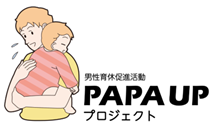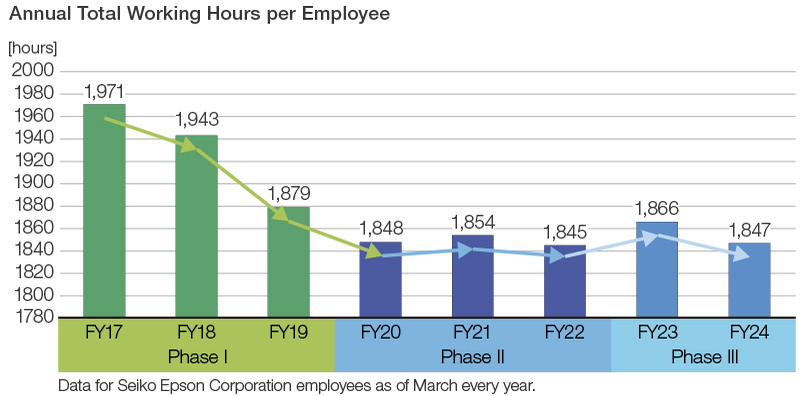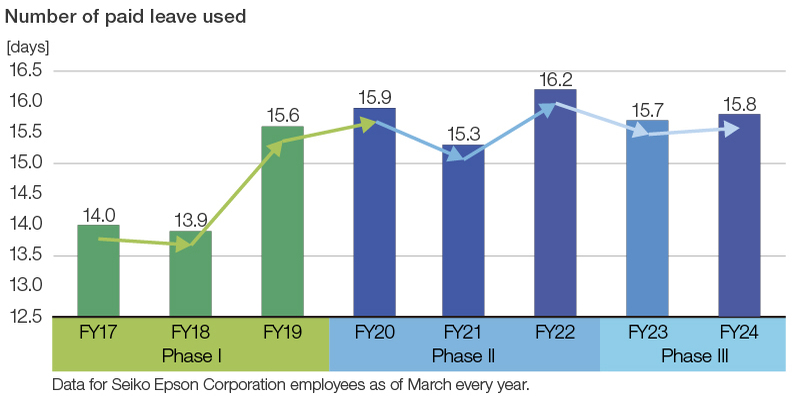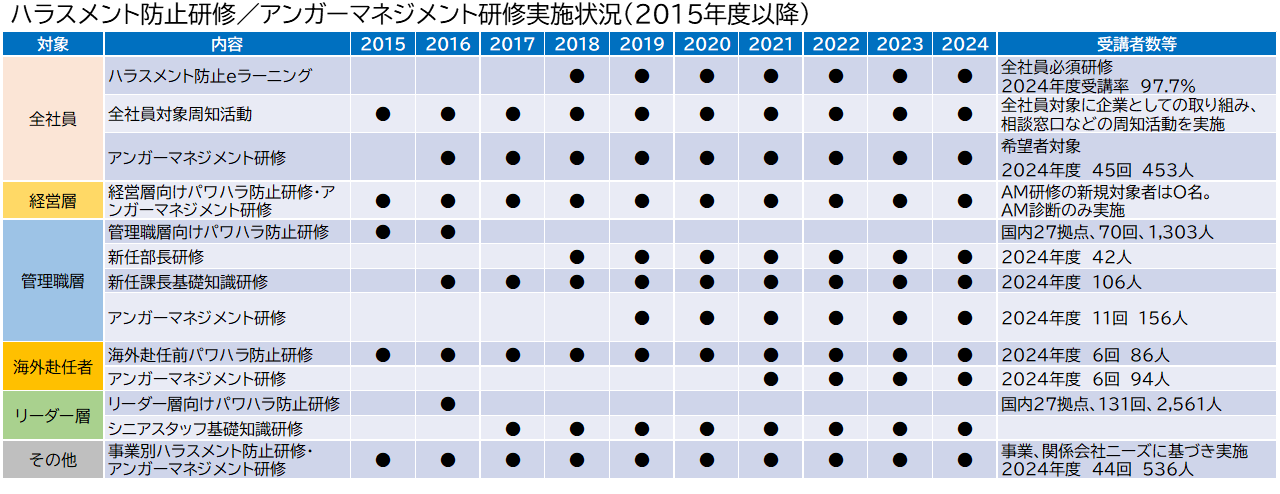Working Environment
Approach
Epson has a diverse workforce, including women, non-Japanese, mid-career hires, people with disabilities, and older workers, and has created an environment in which they can demonstrate their individual strengths. We aim to enable these autonomous and diverse employees to realize their own career development while adapting to changes in various life stages.
In addition to the flextime system and work-from-home, Seiko Epson we are creating an environment where employees can balance work with childcare, nursing care, medical treatment, and infertility treatment by taking advantage of flexibility in working styles through our unique short-time work system that exceeds legal requirements and the "wellbeing leave program" system. We are also working to create a healthy and safe working environment for employees by preventing harassment in the workplace and ensuring appropriate working hours.
Initiatives for Work Styles
In 2004, Seiko Epson established a vision for work and the work culture. The vision aims to create a win-win relationship in which the company can achieve sustainable growth and increase corporate value by enabling all employees to work efficiently and enjoyably through the maintenance and improvement of their physical and mental health, without overwork.
We have been working on work reform since 2017. In Phase I (FY2017-FY2019), we prioritized efforts to optimize working hours and prevent long working hours, and in Phase II (FY2020-FY2022), as part of efforts to diversify and expand options for working styles, we have been expanding systems such as institutionalization of work-from-home for company-wide employees, abolition of core hours during flextime, expansion of applicable age for shorter hours for childcare reasons. In addition, the company has been expanding the applicable age for shorter working hours for childcare reasons (up to the sixth grade of elementary school) and other systems.
In the third phase (FY2023-FY2023-25), starting in FY2023, we are working to firmly establish the operation of the system based on employee autonomy through in-house training and other measures.
Key Actions
| Objective | Main systems |
|---|---|
|
Expansion of Work Options |
Work-from-home system Hourly annual leave Core timeless flex time |
|
Balancing work with childcare, elder care, infertility treatment, etc. |
Support for balancing work and childbirth/childcare Paternity leave acquisition promotion activities Support for employees undergoing fertility treatment Support for balancing work and elder care Wellbeing leave program |
|
Overwork prevention |
Efforts to optimize working hours |
Expansion of Work Options
Work-from-home System
The work-from-home system for childcare and nursing care period introduced in April 2018 has been expanded to include more eligible employees and locations as needs are identified. Currently, the system allows company-wide employees to work-from-home at locations other than their own homes, such as their parents' or spouse's homes.
On the other hand, taking into consideration the importance of face-to-face communication and organizational management issues that were recognized as the work-from-home system progressed rapidly due to the Corona disaster, in September 2023, we set company-wide a guideline (guideline) to come to work at least once a week, and then, depending on each workplace's situation, to work at home in a way that is optimal for organizational productivity and results creation.
In September 2024, the system was revised to allow work-from-home not only on a full-day or half-day basis, but also on a minute-by-minute basis.
Time Off by the Hour
From October 2022, we have introduced an annual leave system based on hourly increments. Employees are now able to take annual paid leave in hourly units up to five days per year.
Flex Time without Core Hours
Effective March 2023, core hours under the flextime system, which applies to many employees, have been abolished. In addition, employees can interrupt work for any reason, allowing for greater flexibility in working hours.
Efforts to Balance Work with Childcare, Nursing Care, and Medical Treatment
Support for Balancing Work with Childbirth/ Child care
With the aim of creating an environment in which employees can be active regardless of their gender in order to realize the career they envision, we are also committed to supporting childcare so that employees can work without gender disparity during childbirth and childcare. We have established systems such as leave, leave of absence, and shortened working hours that allow employees to balance work and childcare while placing importance on childcare.
Childcare Leave Trends
| Female | Ratio of women granted leave | Male | Ratio of men granted leave | |
|---|---|---|---|---|
| 2024*1 | 41 | 100% | 239 | 91.6% |
| 2023*1 | 46 | 97.9% | 208 | 85.2% |
| 2022*1 | 38 | 90.5% | 273 | 97.2% |
| 2021*2,3 | 38 | 100% | 131 | 53.5% |
| 2020*2,3 | 37 | 100% | 72 | 30.8% |
| 2019*2,3 | 41 | 100% | 61 | 21.3% |
| 2018*2,3 | 35 | 100% | 41 | 13.6% |
*Data for employees taking childcare leave. is as of March 31, 2025, Seiko Epson Corporation.
Calculation for FY2022 and thereafter
*1 Ratio of the number of workers who took childcare leave. in the fiscal year before the announcement to the number of workers whose spouse or principal gave birth in the fiscal year before the announcement.
Calculation up to FY2021
*2 Including the number of employees who took wellbeing leave, a system unique to the Company.
*3 Number of employees who took childcare leave / Number of employees covered by the system
(Those eligible for the system: those who have a child of their own and are able to take childcare leave)
Childcare Leave Acquisition Promotion Activities (PAPA UP Project)
With the goal of becoming a company where employees can be fairly involved in childcare and balance work and childcare regardless of gender, the entire company is working to foster a culture in which taking childcare leave is a matter of course and to promote activities to encourage employees to take childcare leave, with the goal that all eligible employees, both men and women, will take such leave.

| Main Activities | Description |
|---|---|
| Childcare leave support tool |
Family meeting sheet to discuss the purpose, timing and duration of maternity leave, division of household chores, etc. Social insurance premium exemption simulator |
| Public awareness activities |
Childcare leave intention registration activity Childcare leave system information sheet Creation of an intranet page explaining the system and procedures as well as income, assessments, etc. Seminars for the employees and their supervisors, as well as roundtable discussions with those who have taken childcare leave. |
Support for Employees Undergoing Infertility Treatment
In response to the social issue of declining birthrates, companies are required to provide a work environment that allows employees to continue working while undergoing infertility treatment. To enable employees undergoing fertility treatment to balance work and work with peace of mind, we have expanded our vacation and leave system from September 2023, and from March 2025, we have made it possible to take leave in half-day increments. This system is used by employees undergoing fertility treatment, regardless of whether they are male or female.
<Support Systems for Infertility Treatment>
| System | Overview |
|---|---|
| Short-term life support leave |
Gives employees five days of special leave (paid leave) which can be taken within a fiscal year. May be taken in installments of one day or half a day. |
| Long-term life support leave |
Allows a total of 365 days of leave to be taken over three fiscal years (can be divided). If continuing treatment even after three years, allows a total of 365 days of leave over the next three years. |
Support for Balancing between Work and Elder Care
As the population ages, more and more employees are caring for family members. With the aim of eliminating job turnover due to elder care, Seiko Epson provides the following support.
- Providing information on the company's elder care system and the long-term care insurance system through our website.
- Seminars on preparation for elder care, which aim to provide employees with knowledge in advance so that they can cope with sudden elder caree needs without panicking.
- Establishment of a contact point where employees can consult on elder care issues with peace of mind.
- Establishment of various systems for balancing elder care and work (details are shown in the table below)
<Caregiver Support System>
| System | Overview |
|---|---|
| Caregiver leave | May take up to 1 year and 6 months per applicable family member |
| Caregiver reduced hours |
Can be taken up to March 20th after three full years from start of use An extension will be granted if ongoing care is necessary. |
| Caregiver overtime exemption | Exempt employees from overtime exceeding nominal hours |
| Caregiver overtime restriction | Restricts employee overtime to less than 24 hours per month or 150 hours per year |
| Caregiver night shift restriction | Restricts night shift assignments for employee |
| Caregiver leave | Allows employee to take 5 days/year for 1 applicable family member or 10 days/year for 2 applicable family members as caregiver leave (unpaid) |
Caregiver Leave Trends
| FY | Caregiver Leave |
Employees using caregiver reduced hours |
|---|---|---|
| 2024 | 5 | 7 people |
| 2023 | 3 | 4 |
| 2022 | 2 | 5 |
| 2021 | 5 | 6 |
| 2020 | 2 | 4 |
| 2019 | 6 | 4 |
| 2018 | 2 | 5 |
*Data for employees taking elder care leave, etc. are as of March 31, 2025, Seiko Epson Corporation.
Epson's Wellbeing Leave Program
This is our unique leave system, which allows employees with remaining paid annual leave from the year before last to accumulate up to 60 days. Seiko Epson can take leave for the purpose of their own injury or illness, elder care or raising a family member, or participating in school events for children up to the third year of junior high school.
(Established March 21, 1998)
Managing Working Hours
Seiko Epson has been acting to more closely manage working hours and prevent long working hours as part of work reforms we began in 2017 and as a priority field in our Health Action 2025 medium-term health management measures we enacted in April 2022. In addition to ensuring legal compliance by familiarizing employees with an operations manual for managing working hours, we monitor in-out times and hours spent at work with automated tracking systems. We also remind personnel of the importance of maintaining reasonable working hours.
Achievements and Targets for Managing Working Hours and Preventing Long Working Hours Through the Above Activities
Total annual actual working hours Target for FY2025: 1,845 hours

Target in FY2025 for number of days of paid leave taken: 20 days (including leave taken other than annual paid leave)

Initiatives to Prevent Harassment
Anti-Harassment Policy
Harassment in the workplace is socially unacceptable behavior that unfairly harms an employee's character and dignity as an individual. It is also an important issue for the company as it interferes with workplace order and business execution and affects its social reputation. Epson has Principles of Corporate Behavior and the prevention of harassment in the Epson Group Human Rights Policy, and in addition, the General Administrative Manager of Human Capital & Well-Being Management Division has sent out a message stating our commitment to the eradication of such harassment.
Employee Advisory Service
Epson has established a harassment consultation service to prevent and eradicate power harassment in order to realize a fair and comfortable working environment. In consideration of the feelings of employees who do not wish to reveal their identities, Epson has integrated the consultation desk for harassment into an external desk opened in 2024 to allow for anonymous consultation. The harassment consultation service strictly manages information on reports, prohibits retaliation against whistleblowers, and ensures anonymity.
In addition, we promote training programs, including horizontal deployment of case examples and sharing of changes in the legal system, in order to improve the care and level of the personnel in charge of labor affairs who handle consultations.
Power Harassment Prevention Training
To foster a healthy and respectful workplace culture, Epson, including its affiliated companies, implements power harassment prevention training programs tailored to each organizational level.
These programs provide comprehensive education on the adverse effects of power harassment on the work environment,
the Group’s policies and stance, and the legal responsibilities of both the organization and individuals.
Topics include the definition of power harassment, its distinction from legitimate supervisory guidance, potential legal liabilities,
and disciplinary measures for perpetrators.
For senior management, the training serves as a strategic opportunity to reflect on and actively promote the creation
of harassment-free organizations, and for managers, the sessions highlight the significant impact of power harassment and encourage proactive countermeasures through case sharing and group discussions.
Every year, we conduct Online Courses education for company-wide employees, including the general public. In addition, we also provide targeted training including for employees assigned to overseas posts, thereby promoting education that is tailored to organizational level and individual responsibilities.
In addition to these measures, since FY2021, we have been promoting the creation of an organizational climate free of power harassment by taking detailed measures tailored to individual workplaces, such as individual follow-up for high-stress workplaces in conjunction with health management information and the establishment of a consultation service for management-level employees.
Harassment Recurrence Prevention
Human rights abuses including harassment and labor-related grievances are regularly reported to executive management. This information and company responses are shared with managers and disclosed company-wide to prevent similar incidents in the future. We require Group companies to report all material harassment incidents. There have been no omissions in reporting in recent years.
Anger Management Training
Anger management" is said to be effective in preventing power harassment.
Since FY2015, we have been developing "Anger Management Training" to help participants acquire skills to deal with anger and control their anger better. The training includes a basic course to acquire skills for dealing with anger on the spot and improving long-term disposition, a scolding class to learn communication skills to avoid power harassment, and others. Over 14,000 people from and affiliated companies in Japan have participated in the courses.
This initiative has been recognized externally. We received the 1st Japan Anger Management Business Leadership Award
Grand Prize for it from the Japan Anger Management Association in June 2023. Through these various initiatives, we strives to build a workplace environment that is free from harassment and enables diverse talent to thrive and contribute with vitality.
Through these and other initiatives, we aim to create a comfortable work environment that is free from harassment and in which diverse human resources can thrive.

(as of March 31, 2025)
Power Harassment Prevention Training/Anger Management Training (after 2015)

Wages
Epson's wage standards are compliant with the local labor regulations in the countries where we operate. Our standards provide for things such as suitable wages, allowances, and extraordinary pay.
The Epson Group Human Rights Policy states "Epson promotes equality of opportunity and treatment in respect to employment, occupation, and remuneration, with a view to eliminating any discrimination." In Japan, Epson pays its people based on the principle of equal pay for equal work, regardless of type of employment, as required by law. The wage system does not discriminate by age or gender. Seiko Epson eliminated the gender pay gap in 1983.
In Japan, for regular employees who are not in management positions, we have introduced a qualified grade-based system wherein compensation is primarily determined by the employee's job and competencies. For leaders, we have a system wherein the compensation is determined by their job, which is given based on their competencies, and the level of roles they are fulfilling. We have a role-based grade system for managers wherein compensation is determined by the size of the person's role. The suitability of non-management employee and leader wages and the wage system are reviewed by a committee made up of members of management and the labor union.
In every country and region outside Japan, we establish rules that are compliant with all local wage-related regulations governing things such as minimum wages, legal benefits, and overtime. Wages, deductions, and so forth are calculated based on these rules, and employees receive an electronic or printed pay stub showing the details of each pay period. Payment is made on directly to employees on the appointed date.
Labor-Management Relations
Epson's Epson Group Human Rights Policy states that, in accordance with the laws and regulations of each country and region, Epson respects freedom of association and the right to collective bargaining, and in order to maintain good labor-management relations, Epson provides workers with the necessary information and engages in discussions and exchanges of opinions in good faith.
A labor-management council forms the basis of the labor-management relationship. Held regularly and as needed,
this council is where management explains important management matters to labor union representatives and where the two sides discuss proposed changes to employment conditions. In addition to the labor-management council, Seiko Epson has formed labor-management committees, the safety and health committee, as well as some other committees, to discuss and solve issues related to things such as working styles, family support, benefits and wages,
post-retirement reemployment, and health management.
Informal discussions are also held on the division and department level to provide a venue for bidirectional communication between employees and managers. Management communicates its thoughts and wishes to employees as well as get direct feedback from them.
* Labor union participation rate among all regular employees: 86.3%
Employee Welfare Programs
Epson offers a variety of welfare programs for its domestic group companies, including health insurance association, defined benefit and defined contribution pension plans, support for asset building through employee stock ownership plan, housing support through company housing and bachelor apartments, and support for leisure time and communication promotion through social gathering assistance and clubs.
Through these welfare programs, Epson aims to create an environment where employees can work with peace of mind and lead fulfilling, healthy lives. These efforts support both the growth of individual employees
and the enhancement of corporate value.
Major Employee Welfare Programs (Japan)
| Category | Program Details | Regular employee | Contract employee | Dispatch worker |
|---|---|---|---|---|
| Social Insurance | Health insurance, employees’ pension Insurance, nursing care insurance, employment insurance, workers’ compensation insurance | - | - | ー |
| Pensions | Corporate Pension Fund, Defined Contribution Pension Plan | - | ー | ー |
| Daily Life Support | Commuting expense subsidy, employee cafeterias & shops, uniform provision | - | - | △ |
| Leisure | Social gathering subsidies, employee clubs | - | - | - |
| Comprehensive service | Packaged Welfare Services | - | - | - |
| Self-Development | Support for correspondence courses and qualification acquisition | - | - | ー |
| Asset building | Employee savings plans, employee stock ownership plan | - | △ | ー |
| Housing | Company housing, bachelor apartments | - | - | ー |
| Health & Medical Care | On-site health management office, in-house therapeutic massage services | - | - | - |
| Childcare & Elder Care | Leave, temporary absence, shortened working hours for childcare/elder care, home care services | - | - | ー |
| Other Support | Congratulatory and condolence payments, long-term service awards, group insurance | - | - | ー |
0: Covered △: Partially covered -: Not covered
Health Insurance (Epson health insurance association)
Approximately 36,000 employees (including dependents) of the Group in Japan are enrolled in the program, which covers medical expenses for illnesses and injuries of employees and their families, provides benefits, and supports disease prevention and health promotion.
Corporate Pension Fund, Defined Contribution Pension Plan
We have introduced a corporate pension fund (defined benefit corporate pension plan) and a defined contribution pension plan for regular employees.
Approximately 15,000 employees are members of the corporate pension fund and approximately 14,000 are members of the defined contribution pension plan.
Clubs
There are approximately 40 clubs and activities organized voluntarily by employees, including soccer, futsal, basketball, marathon, table tennis, badminton, bowling, archery, kendo, mountaineering, skiing, snowboarding, curling, e-sports, drones, shogi, calligraphy, technology research, diversity research, and sauna.
Packaged Welfare Services
Various services are available, including discounts on leisure facilities, restaurant coupons, use of fitness gyms, childcare support, and self-development.
Subsidies for get-togethers held by employees and communication through thank you cards are also provided and used for internal communication.
Employee Stock Ownership Plan
Epson operates an employee stock ownership plan in which participants contribute a fixed amount monthly to purchase company shares.
Approximately 6,000 employees from domestic group companies are enrolled in the program.
As of the latest data, the employee stock ownership plan ranks as the fifth-largest shareholder, holding 2.18% of the company’s shares.
Company Housing and Bachelor Apartments
Epson provides company housing known as "Green Field" and leases apartments near business sites. These accommodations are offered to employees who need housing due to joining the company, relocation, or marriage, etc.



